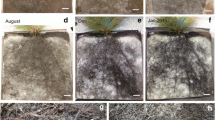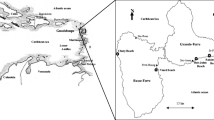Abstract
Polygonum viviparum is one of the first ectomycorrhizal (EM) plant species colonising primary successional sites at the Rotmoos glacier forefront (Tyrolean Alps, Austria). On a site with soil development of about 150 years (2,400 m above sea level), mycobionts of P. viviparum were identified by morphotyping and fungal ribosomal deoxyribonucleic acid internal transcribed spacer sequencing. For studying seasonal dynamics and spatial heterogeneity, ectomycorrhizae were sampled on five plots during all seasons. P. viviparum root tips were always EM. In total, 18 mycobiont taxa of the following genera were identified: Cenococcum (1), Cortinarius (2), Helvella (1), Inocybe (3), Russula (1), Sebacina (2), Thelephora (2) and Tomentella (6). All were non-specific EM partners of EM plants. As early as 2 weeks after spring snow melt, EM were well developed, vital and showed high mycobiont diversity. The relative abundance of senescent root tips was lowest in spring and increased throughout the year, with a maximum in winter (frozen soil). Thus, mycobiont growth and physiological activity obviously start when soil is still under snow cover: We speculate that water availability is one important initiation factor for mycorrhizal development under snow cover, when temperatures still range around the freezing point. Irrespectively of the season, most abundant mycobionts at this primary successional site belonged to the genera Tomentella, Sebacina and Cenococcum, also in frozen soil. Spatial heterogeneity was high when considering species composition and diversity indices. Overall mycobionts species richness was restricted at this site, probably because of the limited availability of fungal partners. We regard the presence/absence of fungal partner and limiting abiotic impacts of the environment as key factors for the symbiotic status of P. viviparum.




Similar content being viewed by others
References
Agerer R (1991) Characterization of ectomycorrhiza. In: Norris JR, Read DJ, Varma AK (eds) Methods in microbiology. Academic, London, UK, pp 27–73
Bacher M (2006) Identifikation der Ektomykorrhizapartner von Polygonum viviparum an einem alpinem Standort der Ötztaler Alpen. Master Thesis, University of Innsbruck
Blaschke H (1991) Distribution, mycorrhizal infection, and structure of roots of calcicole floral elements at treeline, Bavarian alps, Germany. Arct Alp Res 23(4):444–450
Bledsoe CS, Klein P, Bliss LC (1990) A survey of mycorrhizal plants on Truelove Lowland, Devon Island, Northwest Territories, Canada. Can J Bot 68:1848–1856
Colwell RK (2006) Estimates, version 8.0: statistical estimation of species richness and shared species from samples (software and user’s guide)
Dormann CF, Albon SD, Woodin SJ (2002) No evidence for adaptation of two Polygonum viviparum morphotypes of different bulbil characteristics to length of growing season: abundance, biomass and germination. Polar Biol 25(12):884–890
Eriksen M, Bjureke KE, Dhillion SS (2002) Mycorrhizal plants of traditionally managed boreal grasslands in Norway. Mycorrhiza 12(3):117–123
Erschbamer B, Bitterlich W, Raffl C (1999) Die Vegetation als Indikator für die Bodenbildung im Gletschervorfeld des Rotmoosferners (Obergurgl, Ötztal). Ber Naturwiss-Med Ver Innsbr 86:107–122
Fontana A (1977) Ectomycorrhizae in Polygonum viviparum l. In: Abstracts of the 3rd American Conference of Mycorrhizae (NACOM), August 23–25, Athens, GA, p 53
Gardes M, Dahlberg A (1996) Mycorrhizal diversity in arctic and alpine tundra: An open question. New Phytol 133:147–157
Graf F (1994) Ecology and sociology of macromycetes in snowbeds with Salix herbacea L. in the alpine valley of Radönt (Grisons, Switzerland). Diss Bot 235:1–242
Harley JL, Harley EL (1987) A checklist of mycorrhiza in the British flora—addenda, errata and index. New Phytol 107(4):741–749
Haselwandter K, Read DJ (1980) Fungal associations of roots of dominant and sub-dominant plants in high-alpine vegetation systems with special reference to mycorrhiza. Oecologia 45(1):57–62
Hesselman H (1900) Om mykorrhizabildningar hos arktiska växter. Bih K Sven Vetensk-akad Handl 26:1–46
Jumpponen A, Trappe JM, Cázares E (2002) Occurrence of ectomycorrhizal fungi on the forefront of retreating Lyman glacier (Washington, USA) in relation to time since deglaciation. Mycorrhiza 12(1):43–49
Kõljalg U, Larsson KH, Abarenkov K, Nilsson RH, Alexander IJ, Eberhardt U, Erland S, Høiland K, Kjøller R, Larsson E, Pennanen T, Sen R, Taylor AFS, Tedersoo L, Vrålstad T, Ursing BM (2005) Unite: a database providing web-based methods for the molecular identification of ectomycorrhizal fungi. New Phytol 166(3):1063–1068
Krpata D, Mühlmann O, Kuhnert R, Ladurner H, Göbl F, Peintner U (2007) High diversity of ectomycorrhizal fungi associated with Arctostaphylos uva-ursi in subalpine and alpine zones: Potential inoculum for afforestation. Forest Ecol Manag 250(3):167–175
Kühner R (1972) Agaricales de la zone alpine. Amanitaceae. Annales des Sciences de l’Université de Besancon 12:31–38
Kytöviita MM (2005) Asymmetric symbiont adaptation to arctic conditions could explain why high arctic plants are non-mycorrhizal. FEMS Microbiol Ecol 53(1):27–32
Lesica P, Antibus RK (1986) Mycorrhizae of alpine fell-field communities on soils derived from crystalline and calcareous parent materials. Can J Bot 64(8):1691–1697
Massicotte HB, Melville LH, Peterson RL, Luoma DL (1998) Anatomical aspects of field ectomycorrhizas on Polygonum viviparum (Polygonaceae) and Kobresia bellardii (Cyperaceae). Mycorrhiza 7:287–292
McCune B, Grace JB (2002) Analysis of ecological communities. MjM Software, Gleneden Beach, OR
McCune B, Mefford MJ (1999) Pc-ord. Multivariate analysis of ecological data. Version 5.0. MjM Software, Gleneden Beach, OR
Moreau PA, Mleczko P, Ronikier M, Ronikier A (2006) Rediscovery of Alnicola cholea (Cortinariaceae): taxonomic revision and description of its mycorrhiza with Polygonum viviparum (Polygonaceae). Mycologia 98(3):468–478
Nara K (2006) Pioneer dwarf willow may facilitate tree succession by providing late colonizers with compatible ectomycorrhizal fungi in a primary successional volcanic desert. New Phytol 171(1):187–198
Nara K, Nakaya H, Wu BY, Zhou ZH, Hogetsu T (2003) Underground primary succession of ectomycorrhizal fungi in a volcanic desert on Mount Fuji. New Phytol 159(3):743–756
Nemergut D, Costello E, Meyer A, Pescador M, Weintraub M, Schmidt SK (2005) Structure and function of alpine and arctic soil microbial communities. Res Microbiol 156(7):775–754
Nespiak A (1953) Mycotrophy of the alpine vegetation of the Tatra mountains. Acta Soc Bot Pol 22:97–125
Peintner U, Bougher NL, Castellano MA, Moncalvo JM, Moser MM, Trappe JM, Vilgalys R (2001) Multiple origins of sequestrate fungi related to Cortinarius (Cortinariaceae). Am J Bot 88(12):2168–2179
Polatschek A (2000) Flora von Nordtirol, Osttirol und Vorarlberg. Band 3. Tiroler Landesmuseum Ferdinandeum, Innsbruck
Raffl C, Erschbamer B (2004) Comparative vegetation analyses of two transects crossing a characteristic glacier valley in the Central Alps. Phytocoenologia 34(2):225–240
Raffl C, Mallaun M, Mayer R, Erschbamer B (2006) Vegetation succession pattern and diversity changes in a glacier valley, Central Alps, Austria. Arct Antarct Alp Res 38(3):421–428
Read DJ, Haselwandter K (1981) Observations on the mycorrhizal status of some alpine plant communities. New Phytol 88:341–352
Richard F, Millot S, Gardes M, Selosse MA (2005) Diversity and specificity of ectomycorrhizal fungi retrieved from an old-growth Mediterranean forest dominated by Quercus ilex. New Phytol 166(3):1011–1023
Senn-Irlet B (1993) The mycoflora of Alpine mire communities rich in Salix. Arct Alp Mycol 150:235–249
Senn-Irlet B, Jenssen KM, Gilden G (1990) Arctic and alpine fungi. Soppkonsulten, Oslo
Schmidt SK, Lipson DA (2004) Microbial growth under the snow: Implications for nutrient and allelochemical availability in temperate soils. Plant Soil 259(1–2):1–7
Southworth D (2000) CTAB DNA extraction protocol. Available at: http://www.sou.edu/BIOLOGY/Faculty/Southworth/CTAB.htm
Tedersoo L, Suva T, Larsson E, Kõljalg U (2006) Diversity and community structure of ectomycorrhizal fungi in a wooded meadow. Mycol Res 110:734–748
Treu R, Laursen GA, Stephenson SL, Landolt JC, Densmore R (1996) Mycorrhizae from Denali national park and preserve, Alaska. Mycorrhiza 6:21–29
Väre H, Vestberg M, Eurola S (1992) Mycorrhiza and root-associated fungi in Spitsbergen. Mycorrhiza 1:93–104
Vilgalys R (2005) Conserved primer sequences for PCR amplification and sequencing from nuclear ribosomal RNA. Available at: http://www.biology.duke.edu/fungi/mycolab/primers.htm#Internal%20transcribed%20spacer%20(ITS)%20region%20primers
Wang B, Qiu YL (2006) Phylogenetic distribution and evolution of mycorrhizas in land plants. Mycorrhiza 16(5):299–363
Acknowledgements
We thank Rüdiger Kaufmann for the provision of soil temperature and moisture data. Thanks to Regina Kuhnert, Irmgard Oberkofler and Verena Schmid for their assistance in the field and to the anonymous reviewers and Stefan Hutwimmer for their important impacts revising this manuscript. This study is part of the project “Seasonal dynamics of underground EM fungal communities in an alpine primary successional habitat” (P17910-B03) funded by the Austrian Science Fund (FWF).
Author information
Authors and Affiliations
Corresponding author
Electronic supplementary material
Below is the link to the electronic supplementary material.
Supplementary Table S1
Main distinguishing features of Polygonum viviparum morphotypes (MT): descriptions of colour, axis form, mantle surface, emanating elements and mantle layer. (DOC 44 kb)
Supplementary Fig. S1
(GIF 13 kb)
Rights and permissions
About this article
Cite this article
Mühlmann, O., Bacher, M. & Peintner, U. Polygonum viviparum mycobionts on an alpine primary successional glacier forefront. Mycorrhiza 18, 87–95 (2008). https://doi.org/10.1007/s00572-007-0156-z
Received:
Accepted:
Published:
Issue Date:
DOI: https://doi.org/10.1007/s00572-007-0156-z




